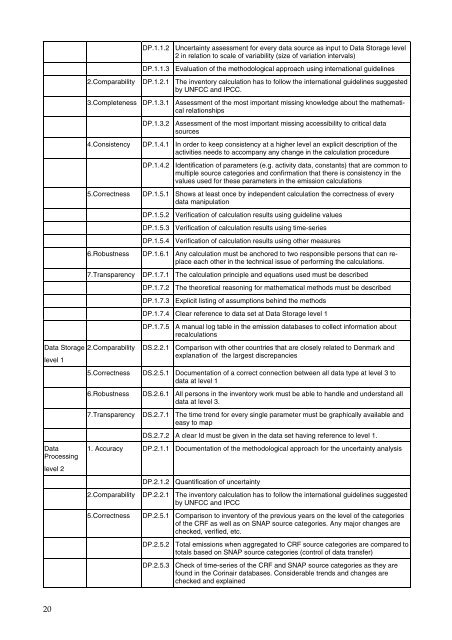Quality manual for the greenhouse gas inventory. Version 1.
Quality manual for the greenhouse gas inventory. Version 1.
Quality manual for the greenhouse gas inventory. Version 1.
You also want an ePaper? Increase the reach of your titles
YUMPU automatically turns print PDFs into web optimized ePapers that Google loves.
Data Storage<br />
level 1<br />
Data<br />
Processing<br />
level 2<br />
20<br />
DP.<strong>1.</strong><strong>1.</strong>2 Uncertainty assessment <strong>for</strong> every data source as input to Data Storage level<br />
2 in relation to scale of variability (size of variation intervals)<br />
DP.<strong>1.</strong><strong>1.</strong>3 Evaluation of <strong>the</strong> methodological approach using international guidelines<br />
2.Comparability DP.<strong>1.</strong>2.1 The <strong>inventory</strong> calculation has to follow <strong>the</strong> international guidelines suggested<br />
by UNFCC and IPCC.<br />
3.Completeness DP.<strong>1.</strong>3.1 Assessment of <strong>the</strong> most important missing knowledge about <strong>the</strong> ma<strong>the</strong>matical<br />
relationships<br />
DP.<strong>1.</strong>3.2 Assessment of <strong>the</strong> most important missing accessibility to critical data<br />
sources<br />
4.Consistency DP.<strong>1.</strong>4.1 In order to keep consistency at a higher level an explicit description of <strong>the</strong><br />
activities needs to accompany any change in <strong>the</strong> calculation procedure<br />
DP.<strong>1.</strong>4.2 Identification of parameters (e.g. activity data, constants) that are common to<br />
multiple source categories and confirmation that <strong>the</strong>re is consistency in <strong>the</strong><br />
values used <strong>for</strong> <strong>the</strong>se parameters in <strong>the</strong> emission calculations<br />
5.Correctness DP.<strong>1.</strong>5.1 Shows at least once by independent calculation <strong>the</strong> correctness of every<br />
data manipulation<br />
DP.<strong>1.</strong>5.2 Verification of calculation results using guideline values<br />
DP.<strong>1.</strong>5.3 Verification of calculation results using time-series<br />
DP.<strong>1.</strong>5.4 Verification of calculation results using o<strong>the</strong>r measures<br />
6.Robustness DP.<strong>1.</strong>6.1 Any calculation must be anchored to two responsible persons that can replace<br />
each o<strong>the</strong>r in <strong>the</strong> technical issue of per<strong>for</strong>ming <strong>the</strong> calculations.<br />
7.Transparency DP.<strong>1.</strong>7.1 The calculation principle and equations used must be described<br />
DP.<strong>1.</strong>7.2 The <strong>the</strong>oretical reasoning <strong>for</strong> ma<strong>the</strong>matical methods must be described<br />
DP.<strong>1.</strong>7.3 Explicit listing of assumptions behind <strong>the</strong> methods<br />
DP.<strong>1.</strong>7.4 Clear reference to data set at Data Storage level 1<br />
DP.<strong>1.</strong>7.5 A <strong>manual</strong> log table in <strong>the</strong> emission databases to collect in<strong>for</strong>mation about<br />
recalculations<br />
2.Comparability DS.2.2.1 Comparison with o<strong>the</strong>r countries that are closely related to Denmark and<br />
explanation of <strong>the</strong> largest discrepancies<br />
5.Correctness DS.2.5.1 Documentation of a correct connection between all data type at level 3 to<br />
data at level 1<br />
6.Robustness DS.2.6.1 All persons in <strong>the</strong> <strong>inventory</strong> work must be able to handle and understand all<br />
data at level 3.<br />
7.Transparency DS.2.7.1 The time trend <strong>for</strong> every single parameter must be graphically available and<br />
easy to map<br />
DS.2.7.2 A clear Id must be given in <strong>the</strong> data set having reference to level <strong>1.</strong><br />
<strong>1.</strong> Accuracy DP.2.<strong>1.</strong>1 Documentation of <strong>the</strong> methodological approach <strong>for</strong> <strong>the</strong> uncertainty analysis<br />
DP.2.<strong>1.</strong>2 Quantification of uncertainty<br />
2.Comparability DP.2.2.1 The <strong>inventory</strong> calculation has to follow <strong>the</strong> international guidelines suggested<br />
by UNFCC and IPCC<br />
5.Correctness DP.2.5.1 Comparison to <strong>inventory</strong> of <strong>the</strong> previous years on <strong>the</strong> level of <strong>the</strong> categories<br />
of <strong>the</strong> CRF as well as on SNAP source categories. Any major changes are<br />
checked, verified, etc.<br />
DP.2.5.2 Total emissions when aggregated to CRF source categories are compared to<br />
totals based on SNAP source categories (control of data transfer)<br />
DP.2.5.3 Check of time-series of <strong>the</strong> CRF and SNAP source categories as <strong>the</strong>y are<br />
found in <strong>the</strong> Corinair databases. Considerable trends and changes are<br />
checked and explained

















